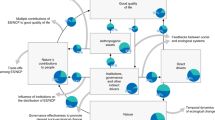
Overview
- This open access book has a Preface by Dr. R.K. Pachauri, Chairman of the Intergovernmental Panel on Climate Change (IPCC)
- Shows how social science integration might lead the way to a sustainable future
- Embraces complexity and presents practical tools for natural resource scientists and managers to address complex social-ecological problems
- Includes supplementary material: sn.pub/extras
Buy print copy
Tax calculation will be finalised at checkout
About this book
In this edited open access book leading scholars from different disciplinary backgrounds wrestle with social science integration opportunities and challenges. This book explores the growing concern of how best to achieve effective integration of the social science disciplines as a means for furthering natural resource social science and environmental problem solving. The chapters provide an overview of the history, vision, advances, examples and methods that could lead to integration.
The quest for integration among the social sciences is not new. Some argue that the social sciences have lagged in their advancements and contributions to society due to their inability to address integration related issues. Integration merits debate for a number of reasons. First, natural resource issues are complex and are affected by multiple proximate driving social factors. Single disciplinary studies focused at one level are unlikely to provide explanations that represent this complexity and are limited in their ability to inform policy recommendations. Complex problems are best explored across disciplines that examine social-ecological phenomenon from different scales. Second, multi-disciplinary initiatives such as those with physical and biological scientists are necessary to understand the scope of the social sciences. Too frequently there is a belief that one social scientist on a multi-disciplinary team provides adequate social science representation. Third, more complete models of human behavior will be achieved through a synthesis of diverse social science perspectives.
Similar content being viewed by others
Keywords
- Climate change and society
- Emerging infectious diseases
- Environmental problem solving
- Facilitating social science integration
- Human sustainability
- Humanity and the biosphere (MAHB)
- Land change research and modelling
- Land degradation and desertification
- Livelihoods, poverty and conservation
- Natural resource social science integration
- Representing human individuals
- Resouce challenges and conflicts
- Risk governance research
- Science during crisis
- Social ecological systems
- Social science integration opportunities and challenges
- Solving sustainability challenges
- Status of integration
- The social-ecological system framework
- Water managing
Table of contents (11 chapters)
-
Front Matter
-
Topics in Integration
-
Front Matter
-
-
Methodological Advances for Facilitating Social Science Integration
-
Front Matter
-
-
Back Matter
Reviews
"This volume is clearly an important contribution to the literature with a proper blending of different disciplines that would help us understand the interface between human society and natural resources in an integral manner." (Dr. R.K Pachauri, Chairman, Intergovernmental Panel on Climate Change)
Editors and Affiliations
Bibliographic Information
Book Title: Understanding Society and Natural Resources
Book Subtitle: Forging New Strands of Integration Across the Social Sciences
Editors: Michael J. Manfredo, Jerry J. Vaske, Andreas Rechkemmer, Esther A. Duke
DOI: https://doi.org/10.1007/978-94-017-8959-2
Publisher: Springer Dordrecht
eBook Packages: Humanities, Social Sciences and Law, Social Sciences (R0)
Copyright Information: The Editor(s) (if applicable) and the Author(s) 2014
Hardcover ISBN: 978-94-017-8958-5Published: 01 July 2014
Softcover ISBN: 978-94-017-8967-7Published: 07 August 2014
eBook ISBN: 978-94-017-8959-2Published: 11 June 2014
Edition Number: 1
Number of Pages: XXV, 261
Number of Illustrations: 36 b/w illustrations, 2 illustrations in colour
Topics: Social Sciences, general, Geoecology/Natural Processes, Human Geography



